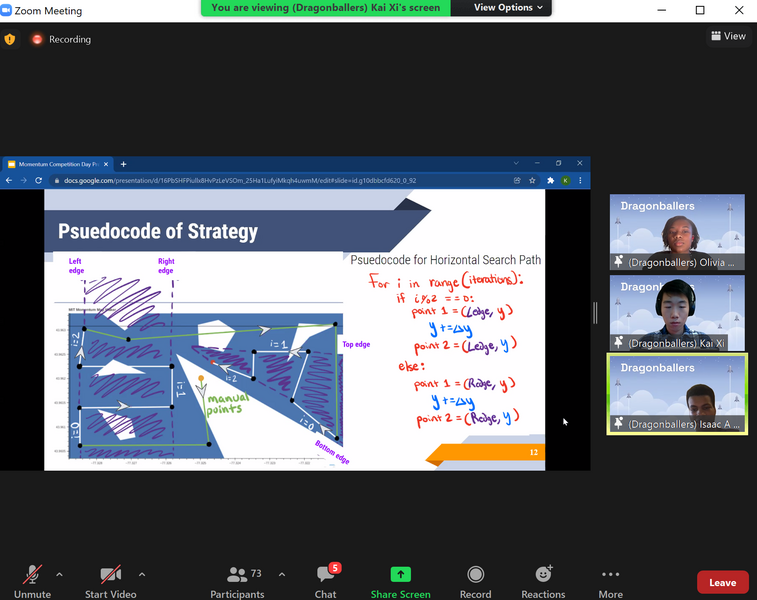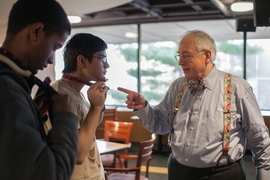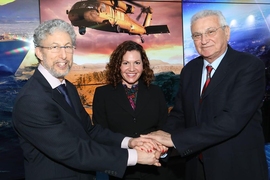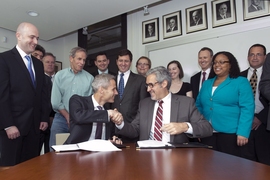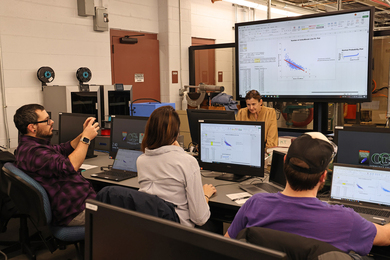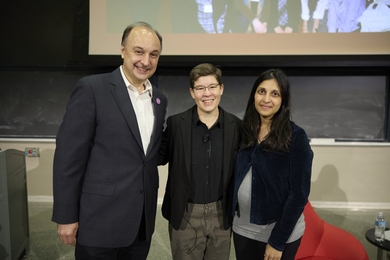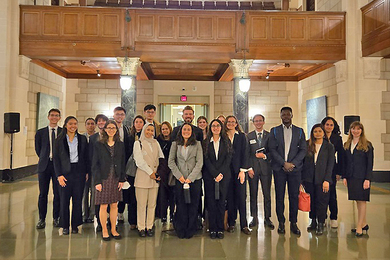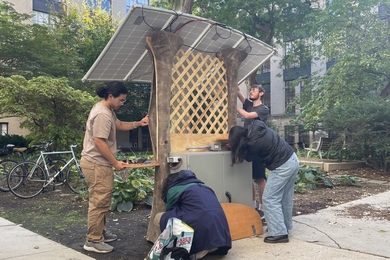During this year’s Independent Activities Period, a group of 29 first- and second-year students immersed themselves in wildfire suppression and search-and-rescue missions. Not literally, of course; these projects were aircraft autonomy simulations, yet they couldn’t be more timely, given the growing incidence of natural disasters attributed to climate change.
The two missions were at the core of this year’s Momentum program, a six-unit interdisciplinary design course facilitated by the Office of Minority Education (OME). The course, which has been offered since 2007, provides an intensive, hands-on engineering experience tackling a real-world problem designed by one of OME’s industry partners. Along the way, students interact with industry representatives, gain valuable experience in working as a team, and polish their presentation and interviewing prowess, among other soft skills. No previous programming or engineering experience is required to participate.
For Momentum 2022, students could choose from two challenges developed by Lockheed Martin: generate mission plans that task a virtual aircraft to either retrieve water and suppress wildfires (Mission 1), or go on a virtual search-and-rescue mission and detect lost people on a map (Mission 2). During the first week of the course, students received instruction from MIT faculty and Lockheed Martin staff to get up and running.
“They did a really good job making sure everyone had the foundation that they need to work on the challenge,” says Esha Ranade, a sophomore majoring in computer science and engineering who worked on the Beachheads team. “We even got one lecture by someone who had been in the Navy who participated in search-and-rescue missions, so they were able to tell us what it was really like to be working in the field.”
During the next few weeks, as students worked on their missions in groups of three or four, they received training in skills like public speaking and interviewing for internships, and even had a career fair. Deliverables such as a proposal review and a design review kept them on track, and the Lockheed Martin staff were always on call via Slack when students had questions or problems. The course culminated in group presentations judged by a panel of representatives from Lockheed Martin and several other companies, including Draper, Raytheon, and STR.
Stephen Kubik, a control laws and autonomy manager for Lockheed Martin, was the industry project lead. “It’s been immensely rewarding,” he says, noting that it was a team effort; 15 staff from Lockheed Martin provided support and guidance to the students throughout the program. “All of us were so enthusiastic to work with the students. There were a lot of late nights getting the code up and running and getting all the case parts and lectures going, but all of it was a labor of love.”
For first-year student Olivia Dias, who was part of the Mission 2 Dragonballers team, one of the most valuable aspects of Momentum was developing collaboration skills, especially with students you’ve never met before. “Sometimes our team would have conflicting ideas, so we’d have to get together to get the best solution. At the end of the day, we all realized we wanted to do our best even though we all had different ideas. It was nice to be able to work collaboratively with others, but also disagree effectively,” she says.
“Momentum reaffirmed my love for aerospace and my desire to be an interdisciplinary engineer,” says Kristoff Misquitta, a first-year student on the Mission 1 Water Nation team. “I also aim to keep applying the structured approach to problem-solving that Momentum instilled: framing challenges in terms of goals, constraints, and complexity trade-offs will always be a vital skill.”
More than 80 people attended this year’s competition on Zoom at the end of January. Even for those without a solid grasp of the missions’ technical aspects, the breadth of solutions the teams came up with was clear. “It’s not an easy problem, and there isn’t one obvious solution,” says Ziyad Hassan, a first-year student on the Mission 2 iFind team. “There are so many solutions that I hadn’t considered, and it inspired me and allowed me to broaden my thinking. It might be a competition, but at the end of the day it’s a learning experience.”
While each student’s particular takeaways may differ, the program as a whole was remarkably successful, especially since teams had to work together remotely because of the pandemic, says OME Staff Associate II Gregory Jain, who oversees Momentum. As a case in point, he notes that 95 percent of students said they’d recommend the course to other first- and second-year students. He credits OME Program Coordinator Harpreet Singh and Program Assistant Deni Cifuentes as key contributors to the program’s success.
For Jain, the best thing about Momentum is “seeing students form friendships and work together as a team to prototype a solution to a real-world problem. It’s important not to forget that these students are only first- and second-year students, so it’s astonishing to see their talents shine as one throughout the three-and-a-half weeks of the course.”
Given how well Momentum 2022 went, Kubik anticipates Lockheed Martin will continue its involvement with the program in the future. “And if the students can walk away from this with an interest in rotorcraft autonomy,” he says, “we consider that just a home run!”
